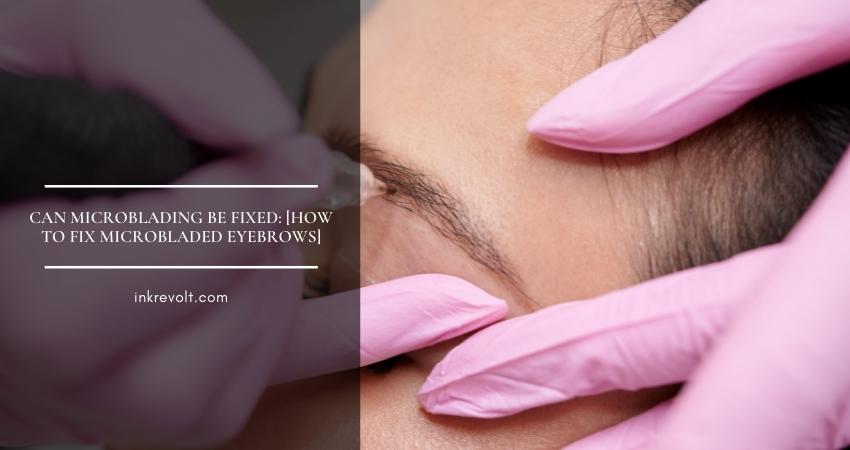Can Microblading Be Fixed?: [How To Fix Microbladed Eyebrows]
There’s no need to panic when microblading goes wrong. It can be frustrating to see the results not matching your expectations, but the good news is that it’s possible to correct a bad microblading job. In this piece, we will tell you what to do if you don’t like your microblading.
So, let’s get right to it!
Can Microblading Be Corrected?
It’s possible to fix a microblading job, no matter how off-putting the initial results were. Make an appointment with an aesthetician and discuss the options you have. The downside is you have to wait a month so that your skin heals entirely from the previous procedure.

Can You Fix Microblading Shape?
Technicians often fail to choose the right brow shape for their clients. This happens when they misjudge the facial proportions and map the brows incorrectly. It happens quite often, but it’s nothing you can’t fix later. Most of the time, a touch-up appointment is all it takes to fix your eyebrow shapes. In more complicated scenarios, technicians use methods like laser removal.
How To Fix Microbladed Eyebrows?
Countless people have experienced below-par microblading results. If you happen to be a part of that unfortunate group, you should be relieved to know that there are many ways to fix the abomination you had gone through earlier. Consult an experienced practitioner and decide which of the following routes you should take.
1. Touch Up Correction
Sometimes, a touchup session is enough to remedy the situation. It’s the first thing you should try if you feel unsatisfied with the eyebrow mapping the artist has done. Wait till the wounds heal before you walk into a beautician’s chamber for a touchup. A color correction can solve the problem if you notice the microblading shades are fading unevenly.
If you browse beauty forums, you will discover that many people are complaining that the microblading color has faded to an unattractive tint. In most cases, it’s a cool blue shade. Thankfully, it’s not hard to make a quick color adjustment, as using an orange-based color will instantly remove the off-putting tinge.
2. Saline
Saline removal is a popular process to fade microblading pigment. You might come across some DIY saline removal tricks on YouTube. We strongly advise against unsupervised saline injection in your body. There’s no point in risking your health to save a little money. Go to skilled technicians who know what they are doing.
The technicians apply a mixture of salt and clean water to the unwanted microblading pigment. They attempt to exploit the scientific principle of osmosis and draw the pigment to the skin’s surface. Once the pigment reaches the outer layer of the skin, it scabs and comes off gradually. You would usually need five to eight sessions eight weeks apart.
There are downsides to this technique, however. First of all, it’s quite expensive. Second, it increases the risk of skin damage because of frequent scabbing. So, choosing this method for a full-on microblading reversal does not make sense from a financial and a medical point of view. Saline removal is ideal for minor touchup sessions.
3. Laser
Many specialists agree that laser removal is the most effective microblading removal strategy. Microblading is different from traditional tattooing because microblading artists don’t put the ink as deep into the skin as tattooists do. But, the laser removal process for both tattoo and microblading is the same.
The laser enters the skin and breaks up the pigment into smaller fragments, which the body absorbs. It works exceptionally well and can completely remove the color. However, you will not get results overnight. You will require anywhere from one to three sessions, each separated by approximately three months.
In addition, because there is pigment in the hair follicle, laser hair removal has the potential to harm the actual eyebrow hairs. And if you want to try microblading again, you must wait at least six weeks following your last laser session. Laser beam penetration exerts a considerable amount of stress on the skin. So, you should wait for the skin to recover.
4. Glycolic Acid
Glycolic acid removal works the same way as saline removal. It extracts the pigment from the skin and scabs it off. However, glycolic acid causes less scabbing than saline removal, which makes the process comparatively safer. But, it can’t guarantee 100% safety from infection and scarring. That said, it can remove the microblading colors entirely after a few sessions.
How To Fix Microbladed Eyebrows That Are Too Thick?
After the first microblading session, many people freak out over their ‘’too thick’’ eyebrows. In most cases, this is a normal part of the process. The colors appear overly bright as they settle in. After a few days, they fade out and form a more pleasant appearance. So, all you need to do in most cases is to wait for a few days.
If the colors don’t normalize after four or five days, that means the artist actually used too much color. No need to panic, however. You can address this issue during your first follow-up session. A simple color correction procedure will get rid of the extra thickness. We recommend choosing a different artist for the touchup since the first person did not do a perfect job.
Final Thoughts
It can be a nightmare when the technician fails to deliver the perfect microblading results. But, you need to remember that it’s a temporary annoyance. Wait out the recovery period patiently and consult your technician to decide what you should do next. You might discover that undoing microblading results are easier than you had initially thought.
